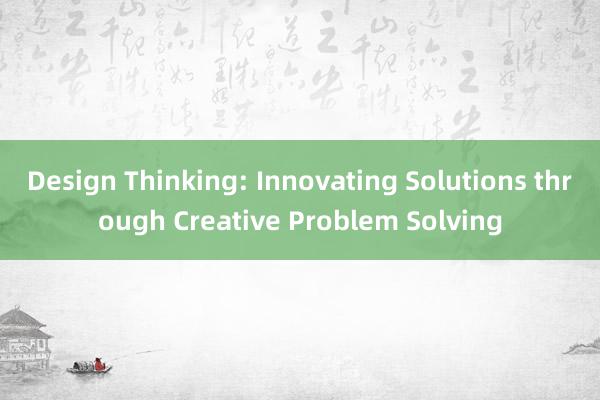时间:2024-09-18 06:40

In today's rapidly evolving world, innovation has become the cornerstone of success for businesses and organizations across various sectors. Design Thinking, a human-centered approach to problem-solving, offers a unique framework that encourages creativity and innovation in addressing complex challenges. By focusing on empathy, ideation, prototyping, and testing, Design Thinking empowers individuals and teams to develop innovative solutions that not only meet but also exceed user expectations.
### Empathy: The Foundation of Design Thinking
Empathy is the first step in the Design Thinking process, where understanding the needs, desires, and challenges of the end-users is crucial. This involves observing,士斯达有限公司 listening, 滁州市南谯区大军家庭农场 and engaging with stakeholders to gain deep insights into their experiences. By putting oneself in the shoes of the users, designers can create solutions that are not only functional but also emotionally resonant, leading to higher user satisfaction and adoption rates.
### Ideation: Generating and Exploring Solutions
Once the empathetic understanding is established, the next phase is ideation. Here,安客圈 the focus shifts from analyzing problems to generating a multitude of potential solutions. Brainstorming sessions, mind mapping, and other creative techniques are employed to foster an environment where all ideas are welcomed, regardless of how unconventional they might seem at first. This open-minded approach often leads to the discovery of innovative solutions that might not have been considered otherwise.
### Prototyping: Bringing Ideas to Life
After a range of ideas are generated, the next step is to prototype these concepts. Prototypes serve as tangible representations of the ideas, allowing stakeholders to visualize and interact with them. This hands-on approach helps in identifying practical limitations and areas for improvement, guiding the refinement of the solution. Prototyping is iterative, meaning it involves creating multiple versions until the most effective design emerges.
### Testing: Validation and Refinement
盐城世纪阳光进出口有限公司The final stage of the Design Thinking process is testing, which involves evaluating the prototypes in real-world settings or through simulations. Feedback from users and stakeholders is crucial during this phase, as it provides insights into the effectiveness of the solution and highlights any remaining issues. Based on this feedback, the solution is refined and iterated upon until it meets the desired outcomes and user needs.
### Conclusion
Design Thinking is a powerful methodology that transforms the way we approach problem-solving by emphasizing empathy, creativity, and iteration. It encourages organizations to think beyond traditional boundaries and fosters a culture of innovation. By integrating Design Thinking into their processes, businesses can develop solutions that not only solve current problems but also anticipate future needs安客圈, ultimately driving growth and competitive advantage in today's dynamic marketplace.